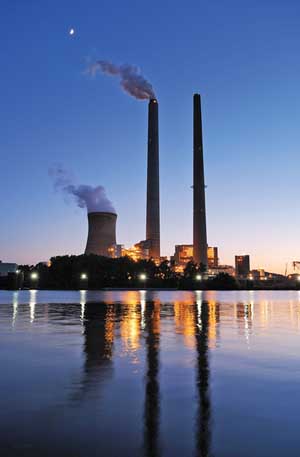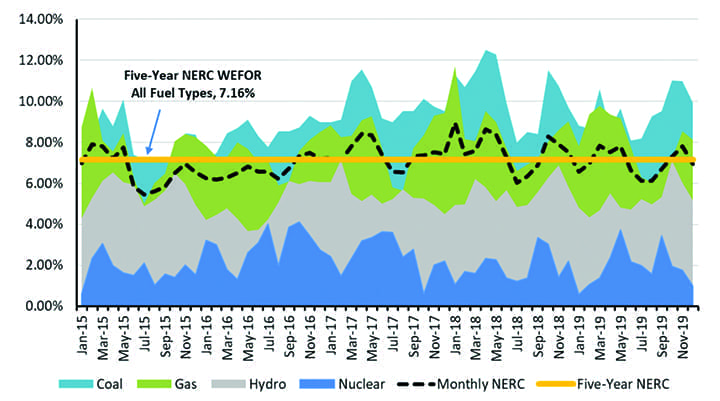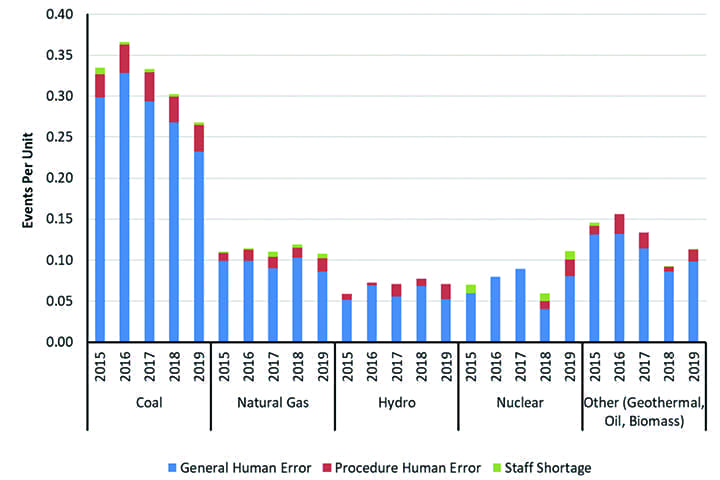Fending Off Forced Power Plant Outages
The post Fending Off Forced Power Plant Outages appeared first on POWER Magazine.

The changing profile of the power system has added new stressors on conventional power generation and may have raised the potential for forced outages. Addressing them requires a closer look at traditional and emerging risks.
Hidden within the North American Electric Reliability Corp.'s (NERC's) July-released 2020 State of Reliability report was an underreported bright spot: The annual Weighted-Equivalent Generation Forced Outage Rate (WEFOR) for 2019 stood at 6.97%, falling below the five-year average of 7.16% for the first time since 2015.
The finding was gleaned from NERC's Generating Availability Data Systems (GADS), a 1982 industry-initiated endeavor to preserve the operating history of the more than 5,000 generating units that are larger than 20 MW on the North American grid. Through GADS-which is today a mandatory industry program-NERC essentially collects information about the performance of power generating equipment, mainly to help the designated electric reliability organization assess generation resources on the bulk power system (BPS), but also to shed light on risks posed by forced outages and trends affecting generation outages.
The WEFOR is perhaps the most important reliability indicator on that front. It provides a mean outage rate-calculated by taking the sum of each unit's capacity-weighted forced outage and derate hours divided by the sum of the total equivalent service, outage, and derate hours. For NERC, the WEFOR's biggest value is that it measures a probability" that a unit will not be available to deliver its full capacity. Individually, these statistics provide important information to plant owners in an effort to benchmark and improve the performance of their own generators," it explained. In aggregate, the statistics help inform system planners about how much generation, reserves, and transmission is needed to meet the reliability needs of the BPS, assuming a calculated amount of generation is unavailability."
 |
1. The North American Electric Reliability Corp.'s (NERC's) overlaid monthly capacity Weighted-Equivalent Generation Forced Outage Rate (WEFOR) by fuel type from 2015 through 2019. The dashed line shows the monthly WEFOR of all fuel types, and the horizontal bar shows the mean outage rate of all fuel types over the five years in the analysis period. Source: NERC |
The decrease in the annual WEFOR is remarkable considering the nation's power fleet is aging. According to a 2017 analysis by the Energy Information Administration, the capacity-weighted average age of hydropower plants in the U.S. is about 64 years, followed by coal at 39 years, and then nuclear at 36 years. However, as NERC's monthly WEFOR of all fuel types shows (Figure 1), coal-fired generation shows a slightly increasing trend over the five-year period. Coal now represents the highest forced outage rate of all conventional fuels, except during extreme winter weather when natural gas-fired generation outages spikes above coal," the report says.
Component FatigueAccording to the National Energy Technology Laboratory (NETL), one reason that coal-fired plants are seeing an uptick in forced outages is because they are being increasingly relied on as load-following resources though they are optimized as baseload resources. In August 2020, citing GADS data, NETL said coal plants are operating at average 50% capacities with low efficiencies, owing to sub-optimal operating parameters," circumstances that will likely continue as more renewables flood the grid.
NETL suggests more than half of forced outages at coal plants across the fleet are caused by boiler tube leaks, followed by mishaps related to balance of plant (15%), steam turbines (13%), generators (12%), and finally, human errors (4%). Meanwhile, nearly 40% of component-based causes of boiler failures can be attributed to waterwall boiler tube leaks. However, components like second superheaters, first reheaters, first superheaters, economizers, and other tube leaks can also cause failures. Fatigue is a cause of failure present across all major boiler components," NETL said, but so are corrosion, creep, and weld defects.
Flexible operations in particular put more stress on steam piping; headers; and superheater, reheating, and waterwall tubing. These issues, notably, are also shared by heat recovery steam generators (HRSGs) at combined cycle gas turbine (CCGT) plants, it said.
Commercial material and process repair solutions are available, but the greater challenge is implementing predictive maintenance capabilities and obtaining acceptance of the business case for costly but necessary upgrades," NETL noted. Other challenges faced by coal and gas plant generators are a lack of historical data on plant components, and a lack of standards to assess cyclic damage and implement associated repairs. NETL suggested more work needs to be done to explore and develop an integrated methodology to predict boiler component life, as well as to develop advanced surface technologies for component life extensions.
According to Intertek's Asset Integrity Management division, the effects of cycling have a large spread" in terms of costs, as well as reliability impacts, with special significance for older conventional units, including coal and older CCGT units, which is why the firm urges that transmission expansion studies include power plant cycling as an input.
Every time a power plant is turned off and on, the boiler, steam lines, turbine, and auxiliary components go through unavoidably large thermal and pressure stresses, which cause damage. This damage is made worse by the phenomenon we call creep-fatigue interaction," Intertek said in a report compiled for the Western Electricity Coordinating Council in May 2020. Relating this discussion to power plants, if an older, base loaded plant (that used to have three to six starts per year and is at 40 to 80% design life from creep damage) is now suddenly dispatched to operate at 50 starts per year, it may take only 2 to 6 years to cause component failure," it explained.
Thus, while cycling-related increases in failure rates may not be noted in the first months, critical components will eventually start to fail. Shorter component life expectancies will result in higher plant equivalent forced outage rates (EFOR) and/or higher capital and maintenance costs to replace components at or near the end of their service lives. In addition, cycling increases may result in reduced overall plant life. How soon these detrimental effects will occur will depend on the amount of creep damage present and the specific types and frequency of the cycling," it said.
Weather-Related LapsesExtreme events related to weather and fires have typically figured prominently as key causes of forced outages in NERC's GADS data, but NERC continues to monitor them for their severe implications on reliability. In 2019, it recorded five days that qualified as extreme."
On these days, the generation portion of the BES [Bulk Electric System] experienced outages that were two to three times as severe as the average day," NERC explained. These outages were initiated by a variety of causes with fuel, ignition, and combustion systems being the main contributor, primarily within the Eastern Interconnection. Additionally, lack of fuel continues to appear as an issue for natural gas and oil units within the Eastern Interconnection during cold weather events."
In 2020, extreme events continued, most prominently in August 2020, when the California Independent System Operator (CAISO) suffered two load-shedding events. In a final root cause analysis released on Jan. 13, CAISO, the California Public Utilities Commission (CPUC), and the California Energy Commission (CEC) pinned the events on a climate change-induced heat wave that drove power demand beyond existing electricity resource planning targets. The final root cause analysis suggests that the supply gap was exacerbated by an underperformance of its natural gas fleet. While it notes the rotating outages were not caused by any single generator or resource type, at least one gas unit, the 494-MW Blythe Energy Center in Riverside County, went out of service because of plant trouble" on Aug. 14. (On Aug. 15, the Panoche Energy Center in Fresno County ramped down unexpectedly from 394 MW to about 146 MW, exacerbating that day's crisis, but CAISO has since determined the ramp down was due to an erroneous dispatch" from CAISO.)
However, acknowledging that Under very high temperatures, ambient derates are not uncommon for the natural gas fleet, and high temperatures reduce the efficiency of these resources," the CEC in December held workshops to explore potential technology options to increase the efficiency and flexibility of the existing gas fleet to meet near-term system reliability as the state transitions to zero-carbon resources. Improvements suggested at one workshop included installing advanced gas path (AGP) technology; inlet air cooling; and other cooling system improvements in combined cycle and simple cycle gas turbines, as well as considering onsite battery storage and software upgrades.
During the session, GE Gas Power and Siemens Energy separately presented a suite of solutions that could be implemented in phases before the summer of 2021 and 2022. AGP would require replacing mechanical components such as blades, buckets, noodles, and shrouds within turbines to enable operational flexibility and efficiency. Inlet air cooling involves cooling the air through evaporative coolers or mechanical chillers before it enters the gas turbine to increase air density. A number of power companies at the session also discussed advantages and disadvantages of some of the suggested solutions, including their results with APG installation, combustion turbine enhancements, and hybrid gas-battery plant operation.
The Bane of Human ErrorNERC's GADS data shows that forced outages attributed to human error averaged 1% of all forced outage events over the past five years-which is small, but still substantial. NERC groups these errors into three categories: general human error, procedural human error, and staff shortage. Only nuclear generation showed a notable increase" in human-error-caused events in 2019 (Figure 2), NERC noted. The sub-causes of staff shortage and procedure human error were present for nuclear generators in 2018 and 2019." Over 2020, the pandemic and its ensuing workforce challenges prompted a number of regulatory changes across the industry, but how human error played out amid these challenges remains to be seen.
 |
2. Generation forced outage events per unit caused by human error since 2015. Source: NERC |
According to NERC, many of the top root causes recorded over the past five years suggest a lapse in company management and organization. Root causes include job scoping that did not identify special circumstances or conditions; system interactions that were not considered or identified; work packages that were inadequately prepared; risks or consequences associated with changes that were not adequately reviewed or assessed; and finally, management policy guidance or expectations that were not well-defined, understood, or enforced.
-Sonal Patelis a POWER senior associate editor.
The post Fending Off Forced Power Plant Outages appeared first on POWER Magazine.